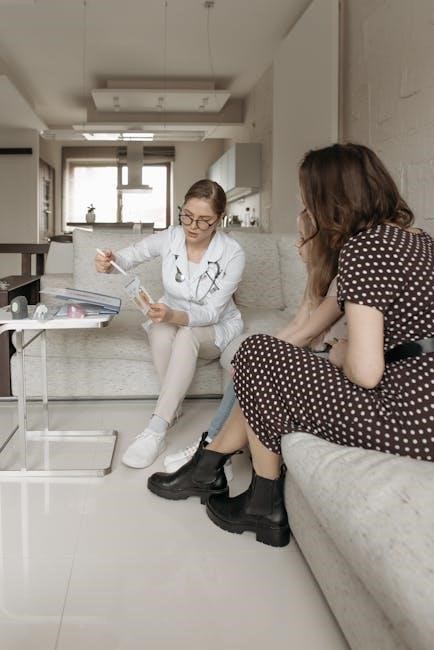
doctor discussion guide
Doctor discussion guides facilitate narrative between patients and doctors, helping patients achieve desired outcomes, using
structured
approaches to improve communication and health results effectively always.

Purpose of Doctor Discussion Guide
The purpose of a doctor discussion guide is to facilitate effective communication between patients and healthcare providers, ensuring that patients receive the best possible care.
A doctor discussion guide is a valuable tool that helps patients prepare for their medical appointments, enabling them to ask the right questions and discuss their concerns openly.
By using a doctor discussion guide, patients can take a more active role in their healthcare, making informed decisions about their treatment and care.
This guide can help patients to clarify their thoughts, prioritize their concerns, and express themselves clearly, which is essential for receiving appropriate medical attention.
The guide can also help healthcare providers to understand their patients’ needs, preferences, and values, allowing them to provide more personalized and patient-centered care.
Overall, the purpose of a doctor discussion guide is to improve the quality of communication between patients and healthcare providers, leading to better health outcomes and increased patient satisfaction.
Effective communication is critical in healthcare, and a doctor discussion guide can play a vital role in achieving this goal.
By promoting open and honest communication, doctor discussion guides can help to build trust, reduce anxiety, and improve the overall healthcare experience.
Importance of Effective Communication
Effective communication is crucial in healthcare, and a doctor discussion guide can facilitate this process.
The guide helps patients to express their concerns, ask questions, and understand their treatment options, which is essential for receiving high-quality care.
Clear communication can reduce errors, improve patient outcomes, and increase satisfaction with care.
It also helps to build trust between patients and healthcare providers, which is vital for a positive healthcare experience.
A doctor discussion guide can help patients to feel more comfortable discussing their symptoms, medical history, and lifestyle, which can lead to more accurate diagnoses and effective treatment plans.
The guide can also help healthcare providers to understand their patients’ needs, values, and preferences, allowing them to provide more personalized care.
By promoting effective communication, doctor discussion guides can improve the overall quality of care, reduce healthcare costs, and enhance patient engagement.
Effective communication is essential for achieving better health outcomes, and a doctor discussion guide can play a critical role in this process, ultimately leading to improved patient care and satisfaction.

Creating an Effective Discussion Guide
Using a
template
can help create a comprehensive and structured doctor discussion guide effectively always online.
Structuring User Interviews
To create an effective discussion guide, structuring user interviews is crucial. This involves identifying the objectives of the research and determining the key questions to be asked. A comprehensive template can be used to guide the interview process, ensuring that all necessary information is collected. The template should include space for noting participant demographics, interview questions, and responses. It is also essential to establish a comfortable and non-threatening environment for the interview, allowing participants to share their thoughts and experiences openly. By structuring user interviews in this way, researchers can gather valuable insights into the needs and concerns of patients, ultimately informing the development of effective discussion guides. Effective structuring of user interviews is critical to the success of the research, and it is essential to approach this process in a systematic and thorough manner, using available online resources and tools;
Practical Tips for Research Sessions
Conducting research sessions for a doctor discussion guide requires careful planning and execution. One practical tip is to set a time limit for each session, typically between 30 and 90 minutes, to keep the conversation focused and on track. It is also essential to have a list of key research questions and assumptions to guide the discussion. Additionally, creating a comfortable and non-threatening environment can help participants feel at ease and share their thoughts and experiences openly. Using a comprehensive template can also help to ensure that all necessary information is collected during the research session. By following these practical tips, researchers can gather valuable insights into the needs and concerns of patients, ultimately informing the development of effective discussion guides. Effective research sessions are critical to the success of the project, and it is essential to approach this process in a systematic and thorough manner, using available online resources and tools to guide the process.

Preparing for a Doctor’s Visit
Patients prepare for doctor visits using guides, improving communication and health outcomes effectively always with online resources.
Keeping a Written Record
Keeping a written record is an essential part of the doctor discussion guide, allowing patients to document their symptoms, questions, and concerns; This record can be used to track progress, identify patterns, and prepare for doctor’s visits. By writing down their symptoms and questions, patients can ensure that they remember to discuss important issues with their doctor. A written record can also help patients to feel more in control of their health and more confident in their ability to communicate with their doctor. Additionally, a written record can be shared with healthcare providers, helping to ensure that patients receive consistent and high-quality care. Using a template or guide can help patients to organize their thoughts and ensure that they are prepared for their doctor’s visit. Overall, keeping a written record is a simple yet effective way to improve communication and health outcomes; Patients can use online resources to find templates and guides to help them get started.
Documenting Symptoms and Questions
Documenting symptoms and questions is a crucial step in preparing for a doctor’s visit, as part of a doctor discussion guide. Patients should write down their symptoms, including when they occur, how long they last, and any factors that make them better or worse. They should also document any questions or concerns they have, no matter how minor they may seem. This can include questions about their diagnosis, treatment options, and any lifestyle changes they need to make. By documenting their symptoms and questions, patients can ensure that they remember to discuss important issues with their doctor. A template or guide can be used to help patients organize their thoughts and document their symptoms and questions. Online resources are available to provide patients with examples of symptom and question logs. Using these tools can help patients to communicate more effectively with their doctor and get the most out of their visit. This helps to improve health outcomes and patient satisfaction.

Conducting a Successful Discussion
Effective communication is key to conducting a successful discussion, using
clear
language and active listening skills always helps patients.
Identifying Objectives and Research Questions
To create an effective doctor discussion guide, it is essential to identify the objectives and research questions that will guide the conversation. This involves determining what information is needed to achieve the desired outcomes and what questions need to be asked to gather that information. A clear understanding of the objectives and research questions will help to focus the discussion and ensure that all relevant topics are covered. Using a
structured approach
to identify objectives and research questions can help to ensure that the discussion guide is comprehensive and effective. By taking the time to carefully consider the objectives and research questions, healthcare professionals can create a doctor discussion guide that is tailored to the specific needs of their patients and helps to improve health outcomes. Effective identification of objectives and research questions is critical to the success of the doctor discussion guide.
Setting a Time Limit and Staying on Track
Setting a time limit is crucial when conducting a discussion using a doctor discussion guide, as it helps to ensure that the conversation stays focused and on track. A typical time limit for a research session is between 30 and 90 minutes, depending on the complexity of the topics being discussed. By setting a time limit, healthcare professionals can help to prevent the conversation from straying off topic and ensure that all relevant questions are answered. Using a
timer or schedule
can help to keep the discussion on track and ensure that the time limit is adhered to. Staying on track is essential to achieving the objectives of the discussion and gathering the necessary information to improve health outcomes. Effective time management is critical to the success of the doctor discussion guide, and setting a time limit is an important part of this process, helping to keep the conversation productive and efficient.

